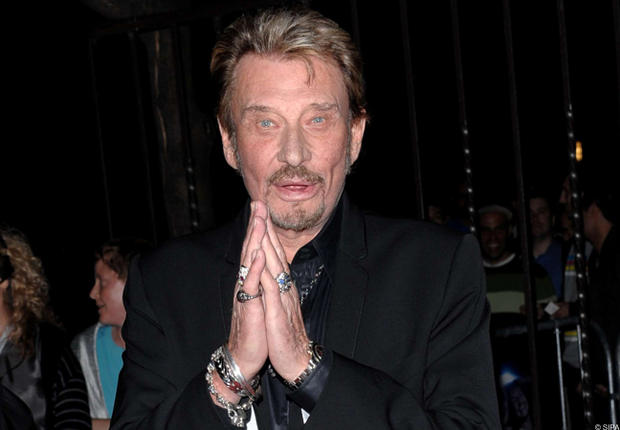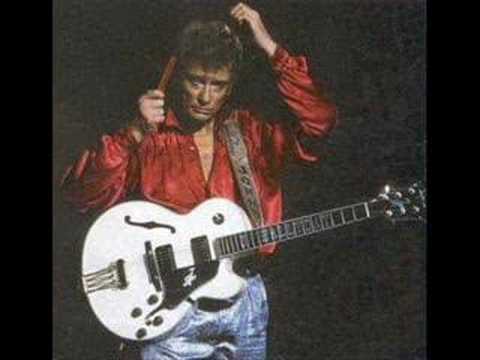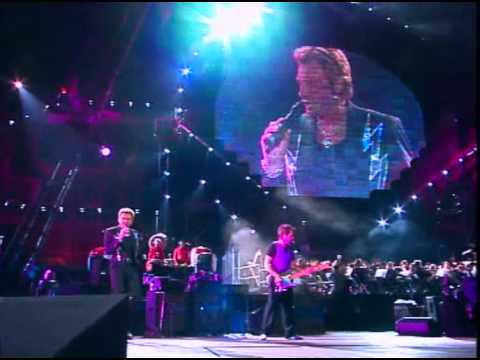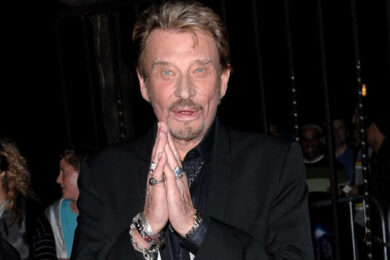This month marks a watershed for Anglo-French relations – Johnny Hallyday is coming to London. For the first time the French icon, responsible for influencing Gallic musical tastes for over five decades, will perform on English soil, playing two nights at the Royal Albert Hall. Hallyday will be promoting his forty-eighth studio album, L’Attente, planned for release at the beginning of November. The album’s eponymous single showcases a voice that is as strong as ever and, despite repeated announcements of retirement and endless farewell tours, at nearly seventy the king of French stadium rock just can’t hang up the leather trousers. Often referred to as the ‘French Elvis’, Hallyday’s image in Britain has been more akin to the ‘French Cliff Richard’, but this ignores both his constant courting of controversy and the real strength of his balladry. While it is true that ‘mediocre’ has been his default setting musically, as a performer and personality Hallyday has been anything but, constantly innovating and pushing the boundaries of pomp and excess, and coming to occupy an iconic position in French popular culture. Often naff, sometimes inspired, never boring, Hallyday is a study in showmanship, fame and French identity.
L’Idole Des Jeunes
Hallyday’s back story is almost too good to be true, and it is difficult to separate fact from fiction. Parallels can be drawn with another French icon, Édith Piaf, whose highly fictionalised biography, published after her death by her putative half sister, established a number of anecdotes as fact in the popular imagination. The story goes that, like Piaf, Hallyday was born into the grass roots of performance – his estranged father was a clown and juggler, and he was brought up by his paternal aunt, a former silent film star. His apprenticeship in performance was with his cousins Menen and Desta, and the latter’s American dancer husband, Lee Halliday. The trio formed a dance troupe, travelling all over Europe with the young Johnny in tow. Lee became a father figure to Johnny, he took his surname (an early record cover misprint saw Johnny’s stage-name become ‘Hallyday’ instead of ‘Halliday’), and learned the art of performance at his knee. Trained in dance, the guitar and violin, the blond haired, blue-eyed Johnny was a born teen idol, but he had to wait for the ultimate pop star to arrive on the scene before things began to happen for him.
When Elvis broke through in 1957, a fourteen year old Johnny was faced with the template that would inform not just his whole career, but his sense of self (when Elvis died, Hallyday proclaimed ‘The whole of my youth died today’). Cutting his teeth singing at American army bases, his shtick was simply a passable impression of the King himself. Aged just sixteen, Hallyday signed a record deal with the French label, Vogue, got a supporting slot on a Sacha Distel tour, and gained Charles Aznavour as a mentor. Johnny’s star was rising and, with his performances becoming notorious for their atmosphere of teenage hysteria, he quickly gained a reputation as a rock & roll rebel. His appearance at the 1961 Festival de Rock in Paris, just a few months after his debut album Hello Johnny was released, became legendary for his outrageously energetic performance and the stadium riot that ensued. Already Hallyday had a ‘wild man’ tag that made him more than a bland pop faker, and a string of film performances in Westerns and crime thrillers aimed at the teenage market only consolidated his image as a brooding malcontent.
Encore Une Fois
As the ‘idol of the young’ Hallyday had an edge to him, but musically his approach was pedestrian. After exhorting the French to ‘danse le twist’ in 1961 (the year after Chubby Checker had encouraged the Americans to do the same), the 1962 single ‘C’est le mashed potatoes’ explained the dance craze to the French (‘In America all the young people dance it/ It’s a bit like the Charleston’). This vampiric approach to American pop continued unabated into the mid-sixties as Hallyday engaged in a process of simply re-recording British and American hits with French lyrics – a pattern he has never fully shaken off. 1962’s Johnny Hallyday Sings America’s Rockin’ Hits, recorded in Nashville, was a failed early experiment in recording in English (think "I found my t’rill on Blueberry ‘ill"), and although it resulted in appearances on The Ed Sullivan Show, a career in the American musical mainstream never came to fruition. French would be the language in which Hallyday made his name, and it’s unlikely he would have the status in France he enjoys today if he had continued to sing in English. By the early sixties Hallyday had already established his brand – taking on the looks and sounds of Anglophone popular music wholesale and flogging them back to the French.
Hallyday was quick to pick up on the songs scaling the charts across the pond, and he would cut his own versions within weeks of the appearance of the originals. The Animals’ ‘House Of The Rising Sun’ became ‘Le pénitencier’, Stevie Wonder’s ‘Uptight’ became ‘Les Coups’, while The Crystals’ ‘Da Doo Ron Ron’ and Los Bravos’ ‘Black Is Black’ were also re-recorded with French lyrics shortly after their original release. Hallyday was not alone among French popsters in employing the tactic of transposing such material into French, and while his real strength was as a performer who could drive the fans wild live, he was still doing more than producing the equivalent of a Woolworths anonymous covers album. The new French lyrics, along with Hallyday’s characteristically dramatic delivery, meant these recordings were more than uncreative pastiche, but he still lacked a voice of his own. Military service in 1964-65, during which time he married yé-yé chanteuse Sylvie Vartan, was to herald a change in direction, and a more mature Hallyday began to seek artistic credibility as the decade’s second half dawned.
La Génération Perdue
Hallyday’s new ambitions were signalled by the 1966 single ‘Cheveux Longs Et Idées Courtes’, with its lyrics referencing Kennedy, Ghandi and the Vietnam War. Anticipating the Summer of Love in its sentiments, the single was not well-received by a public still clinging to Hallyday’s teen idol image. Unperturbed, he formed a touring band called the Blackburds, featuring later Spooky Tooth and Foreigner guitarist Mick Jones, and drummer Tommy Brown. The pair provided Hallyday with a substantial body of psychedelia and mod rock-tinged original material, with their writing first appearing on his album La Génération Perdue. In this period Hallyday also engaged some impressive collaborators. He booked The Jimi Hendrix Experience as the opening act for his 1966 tour, having met Hendrix during a trip to London, and he later covered ‘Hey Joe’ in French. The track ‘À Tout Casser’, from 1968’s Jeune Homme, featured both Jimmy Page and the recently lamented Big Jim Sullivan, while the following year’s Rivière… Ouvre Ton Lit featured three Steve Marriott and Ronnie Lane-penned tracks, with backing from The Small Faces themselves, as well as guitar work from Peter Frampton. RPM International recently revisited these most creative years of Hallyday’s career in their compilation Le Roi De France: Johnny Hallyday 1966-1969 – a long overdue rediscovery which showed him in a new light.
As the seventies loomed, Hallyday had still not entirely abandoned the flower child spirit of ‘Cheveux Longs Et Idées Courtes’, recording the self-explanatory ‘Jésus Christ (Est Un Hippie)’. The song caused a scandal, suiting Hallyday’s continued attempts to shake off his teeny-bop image. The seventies nevertheless saw him offer a mixed bag of material. His 1970 album Vie was heavily inspired by the American protest song, with the opening track, ‘Essayez’, condemning "war mongers" while championing "love, peace and freedom", and on the album’s big hit, ‘La Fille Aux Cheveux Clairs’, Hallyday’s vocal was a full-blown Dylan impression. Following 1971’s successful album Flagrant Délit, Hallyday flirted with country on 1972’s Country, Folk, Rock, and pulled a Johnny Cash by playing Switzerland’s Bochuz high security prison in the same year. The leather jacket and acoustic were soon abandoned for wide, sequinned lapels and a flying-V as the seventies progressed. Jones and Brown had bailed out by 1973, with French composer Michel Mallory taking over song-writing duties, but 1974’s Rock’n’Slow saw the covers format return with a vengeance, featuring songs by the Stones, Elvis, Chuck Berry and Eddie Cochran. The late seventies would be littered with similar covers albums. Hallyday was on the slide, but his dramatic talents were to lift him from mediocrity.
Mes Yeux Sont Fous
By the late seventies it was clear that Hallyday was far more important as a live performer than as a recording artist. Touring tirelessly, Hallyday’s live albums had been a staple of his output from the very beginning (the current total stands at twenty-six and counting). By 1979 Hallyday had already staged some outlandish spectacles and had established himself as a complete stranger to subtlety. In 1967 he had experimented with concert audio visuals on an ambitious scale while, in a neat comment on his roots and essential character as a performer, the 1972 show Johnny Circus was staged in a big top. 1976 had seen the first of Hallyday’s experiments with rock opera – a strongly prog-influenced double concept album based on Shakespeare’s Hamlet – but the record flopped and the accompanying show never happened. Hallyday’s ambitions were far from dampened and in 1979 he staged L’Ange Aux Yeux De Lasers – a sci-fi spectacular, using the kind of light show Jean Michel Jarre had unveiled just months earlier at his famous Bastille Day concert at Paris’s Place de la Concorde. With characteristic aplomb, Hallyday wore a silver spacesuit and goggles which shot lasers at the audience, and the attendance figures for this show alone were over a quarter of a million.
Hallyday’s early 1982 album, Quelque Part Un Aigle, bombed, but he continued to strive for originality in his live productions, sticking to the mantra, "I want to do a show that is completely new in France." Taking on the Judas Priest ‘leather and studs’ look, and clearly influenced by the pantomimic excesses of KISS and Alice Cooper, Hallyday embraced Spinal Tap-style theatricality with renewed verve in late 1982. Staged at Paris’s Palais des Sports, Fantasmhallyday featured eighty performers in a post-apocalyptic, zombie and vampire-themed display of sheer stagey nonsense, while the video for the title track of the accompanying concept album, La Peur, featured Hallyday singing against a backdrop of macabre Hieronymus Bosch paintings. Silk-shirted, tight-trousered, blues-rock main-streamness beckoned in the mid-eighties, and the highly successful album Rock ‘n’ Roll Attitude set the tone for the following decades. But Hallyday’s dramatic talents continued to be employed in a string of acting engagements, from Jean-Luc Godard’s 1985 film Détective, to his acclaimed 2002 performance in the sparse drama L’Homme Du Train, and he didn’t abandon his elaborate live shows either. Routinely arriving on stage by helicopter or in an explosion of pyrotechnics, Hallyday’s year 2000 show, 100% Johnny: Live à la Tour Eiffel, saw him appear in a huge silver sphere. The show attracted a live audience of half a million, with over nine million people watching on French TV. Such huge popular appeal requires more than just spectacle – it needs depth too – and the French have found that in Johnny.
C’est En France
When, during the 2002 French presidential election campaign, Prime Minister Jean-Pierre Raffarin attempted to identify himself with grassroots France – ‘La France D’En Bas’ – he explained that he was referring simply to "the France that listens to Johnny". Despite his superstar status, Hallyday had come to be seen as an everyman figure – a self-made man with an instinctive understanding of the French masses. The bombast of his music has been central to this image of earthiness, and the thread running through the whole of Hallyday’s career has been the overblown ballad. The melodrama of sixties and seventies classics like the sexually-charged ‘Que Je T’Aime’ (Camille’s beautiful cover from last year reveals just what an incredible piece of song-writing this is), ‘Requiem Pour Un Fou’ (the story of a crime of passion), and the tortured ‘Ma Gueule’, are where Hallyday’s strong dramatic sensibility and powerful voice have met to produce his most enduring work. With the invaluable contribution of his long-time lyricist Gilles Thibaut, Hallyday has taken traditional French balladry in new directions, changing the paradigm forever, and this is the foundation of the popularity of his music in France.
Hallyday’s status as France’s Performer in Chief was confirmed when he sang La Marseillaise at the French-hosted 1998 World Cup, and later performed to hundreds of thousands of people in Paris on Bastille Day 2009 at the request of high-profile fan President Sarkozy. Receiving France’s highest honour when he was made a Chevalier De La Légion D’Honneur in 1997, Hallyday’s sixtieth birthday saw Le Figaro sum up his importance to French culture by likening the effect of his songs for the French to that of Proust’s madeleine. Hallyday is, before anything else, France’s own rocker, singing in their own language (the commercial annihilation of 1994’s English-language Rough Town showed that it is only when Hallyday paints Anglophone pop in French hues that his music is successful), and he has retained this status despite having long lived outside the country as a tax exile. The extent of his die-hard devotees’ loyalty to him was made clear in 2009 when the surgeon accused of botching an operation that left Hallyday in a coma was attacked by masked men at his Paris home – it was suggested that Hallyday fans were responsible. It seems that if you cross Johnny Hallyday, you cross sixty-five million French citizens.
Ca Ne Change Pas Un Homme
Today Hallyday is still top of the French A list and remains a staple of the French tabloids. With a career that has included health scares, tax problems, acrimonious record company splits, alleged substance abuse, five wives, four children and three grandchildren, controversy has never been far from the Hallyday camp, and little has changed recently. A heart scare and emergency airlift from his holiday home on the Caribbean island of St Barts in August this year, followed by a stay at the Cedars-Sinai hospital at the beginning of last month, caused huge speculation in the French press and prompted the inevitable Paris Match cover story. But Hallyday has soldiered on with the current tour, performing his first ever New York concert only on Sunday. Married to a model thirty-two years his junior, with two small children adopted from Vietnam, Hallyday lives like a man half his age, and his material isn’t that of someone tired of life either. Last year’s album, Jamais Seul, was a highly listenable piece of atmospheric, bluesy rock, with production and writing from influential singer-songwriter Matthieu Chedid (best-known here for providing the title song for the Belleville Rendez-Vous soundtrack, and notorious in France for his Ziggy Stardust-goes-rockabilly alter-ego ‘-M-‘). Hallyday’s voice sounds more authentic and gravelly than ever, reflecting both his age and his taste for filterless Gitanes, while his leather-clad, tattooed look, and plastic-surgeried yet animalistic face, are suitably intriguing. Hallyday remains exactly what a superstar should be – a force of nature.
Johnny Hallyday is appearing at the Royal Albert Hall on October 15 & 16






